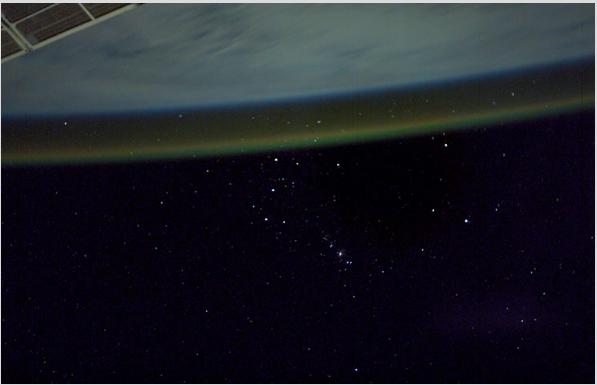Airglow from Earth Orbit
Airglow from Earth Orbit: Exploring the Enigmatic Phenomenon
Have you ever gazed up at the night sky and noticed a faint glow? That ethereal illumination, known as airglow, is a fascinating natural phenomenon that occurs in the Earth's atmosphere. While airglow is visible from the surface of our planet, it takes on a mesmerizing quality when observed from space. In this article, we will delve into the captivating world of airglow as seen from Earth orbit, shedding light on its characteristics, origins, and the scientific significance it holds.
The Enigmatic Band of Light
When viewed from orbit, airglow appears as a narrow band of radiant light. Its brightness is most pronounced at an altitude ranging from 90 to 100 kilometers (55-62 miles) above the Earth's surface. This celestial glow is not uniform; instead, it exhibits variations in intensity and color across different regions of the atmosphere. The airglow band can stretch across vast distances, captivating astronauts aboard the International Space Station (ISS) as they witness the spectacle of constellations like Orion setting through its luminous layer.
Unveiling the Mysteries of Airglow
Airglow arises from a complex interplay of atmospheric processes and interactions with solar radiation. While sunlight provides the primary energy source for airglow, the exact mechanisms behind its formation are still not fully understood. Scientists believe that the phenomenon arises due to several factors, including:
- Excitation and ionization of atmospheric molecules by solar ultraviolet (UV) radiation
- Chemical reactions between excited atoms and molecules
- Radiative recombination of ionized particles
The Spectrum of Airglow
Just as sunlight comprises a spectrum of colors, airglow also exhibits a diverse range of hues. By analyzing the light emitted by airglow, scientists can gain valuable insights into the composition and dynamics of the upper atmosphere. The most prominent colors observed in airglow include green, red, and blue. These colors arise from specific atomic and molecular transitions, such as the emission of oxygen atoms at green wavelengths and hydroxyl molecules at red wavelengths.
Unraveling the Origins
To unravel the origins of airglow, scientists employ a range of instruments and techniques to study its characteristics. Spectrographs, for instance, enable the analysis of the emitted light's wavelength distribution, providing information about the chemical composition of the upper atmosphere. Advanced imaging sensors aboard satellites and space probes capture stunning visuals of airglow, allowing scientists to investigate its spatial distribution and temporal variations.
Scientific Significance
Airglow serves as a crucial tool for scientists studying various atmospheric phenomena. By analyzing the intensity and spectral properties of airglow emissions, researchers can gain insights into fundamental atmospheric processes, such as:
- The dynamics of the upper atmosphere
- The presence and behavior of trace gases
- The impact of solar activity on Earth's atmosphere
Moreover, airglow observations aid in understanding the intricacies of global atmospheric circulation patterns, which play a vital role in climate dynamics and weather systems.
Collaborative Research Efforts
Given the interdisciplinary nature of airglow research, scientists from diverse fields collaborate to unravel its mysteries. Atmospheric physicists, chemists, astronomers, and remote sensing experts join forces to analyze airglow data collected from ground-based observatories, aircraft, and space missions. By combining their expertise, these researchers contribute to a comprehensive understanding of this captivating atmospheric phenomenon.
Beyond Earth Orbit: Airglow in the Solar System
While airglow is primarily studied in Earth's atmosphere, similar phenomena have been observed in other celestial bodies within our solar system. Planets like Mars, Venus, and Jupiter exhibit their own versions of airglow, offering valuable comparative insights into atmospheric processes beyond our planet. Studying airglow in the solar system expands our understanding of the universe and provides a broader context for Earth's atmospheric dynamics.
Inspiring Wonder and Curiosity
Airglow, with its ethereal glow and captivating properties, continues to inspire wonder and curiosity among scientists and space enthusiasts alike. Its presence reminds us of the intricate beauty that lies within our atmosphere and the mysteries that await exploration. As we continue to unravel the complexities of airglow, we gain a deeper appreciation for the interconnectedness of Earth's systems and the vastness of our universe.
Conclusion
Airglow from Earth orbit is a mesmerizing sight that showcases the dynamic nature of our planet's upper atmosphere. Through the collective efforts of scientists from various disciplines, we are gradually unraveling the secrets behind this enigmatic phenomenon. As our understanding deepens, airglow will undoubtedly continue to captivate us, offering valuable insights into atmospheric dynamics, climate processes, and the wonders of the universe.

Airglow from Earth Orbit
The airglow, brightest at a height of 90 - 100 km (55-62 mile), appears from orbit as a narrow band.
In this view taken from the ISS the constellation of Orion is setting through the airglow layer.
Imagecourtesy of the Image Science & Analysis Laboratory, NASA Johnson Space Center.
Note: this article has been automatically converted from the old site and may not appear as intended. You can find the original article here.
Reference Atmospheric Optics
If you use any of the definitions, information, or data presented on Atmospheric Optics, please copy the link or reference below to properly credit us as the reference source. Thank you!
-
<a href="https://atoptics.co.uk/blog/airglow-from-earth-orbit/">Airglow from Earth Orbit</a>
-
"Airglow from Earth Orbit". Atmospheric Optics. Accessed on November 22, 2024. https://atoptics.co.uk/blog/airglow-from-earth-orbit/.
-
"Airglow from Earth Orbit". Atmospheric Optics, https://atoptics.co.uk/blog/airglow-from-earth-orbit/. Accessed 22 November, 2024
-
Airglow from Earth Orbit. Atmospheric Optics. Retrieved from https://atoptics.co.uk/blog/airglow-from-earth-orbit/.